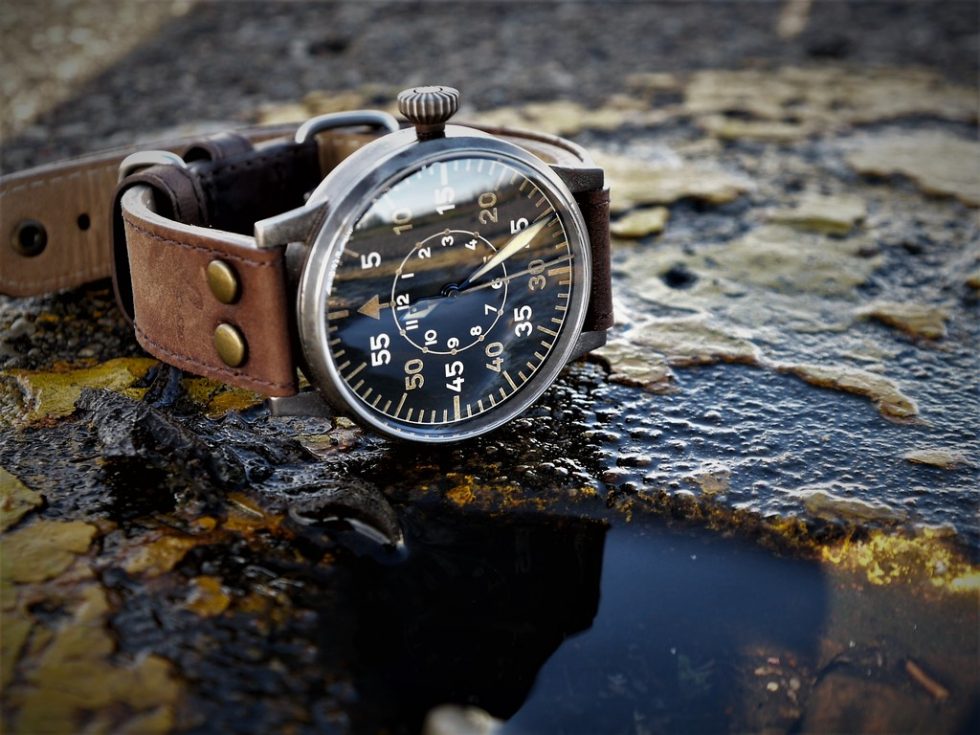Being into watches for about four decades now, I’ve always felt and still feel attracted to aviator watches in general, and Beobachtungsuhren in particular. For today, we bring you an extensive LACO Leipzig Erbstück Review.
The German term “Beobachtungsuhr” dates back to navigator’s watches of WW II.
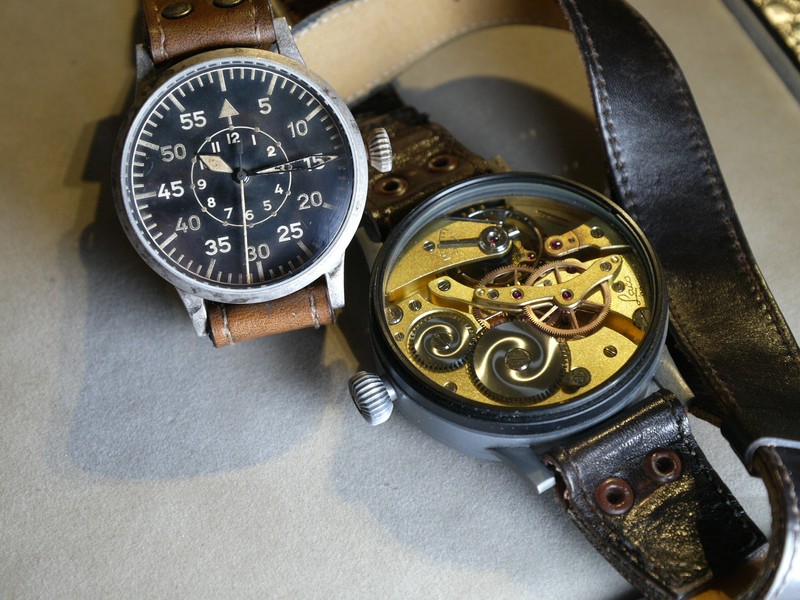
Strictly translated it would equal to “observation watch”, but on most watch related fora you’ll read either “pilot’s watch“, “B-watch“, “B-Uhr” or just “Flieger“, which is the term I like most.
As a brief historical overview, Beobachtungsuhren have been made for the German Luftwaffe by only 5 manufacturers: A. Lange & Söhne, Laco (Lacher & Co), Stowa (Walter Storz), Wempe (Chronometerwerke Hamburg), and IWC
These contained high quality pocket watch movements:
Lange & Söhne: Cal. 48/1 (due to limited capacities watches have been assembled by Huber/Munich, Felsing/Berlin, Schieron/Stuttgart, Schätzle & Tschudin/Pforzheim, Wempe/Hamburg)
Laco: Durowe cal. D 5
Stowa: Unitas cal. 2812
Wempe: Thommen cal. 31
IWC: Cal. 52 SC (SC = “seconde central“)
A Brief History of LACO
The company Lacher & Co.—the name LACO deriving from the first syllables of each word—was founded by Frieda Lacher and Ludwig Hummel in Pforzheim in the middle of the 1920s. At the time, Pforzheim’s many watch manufacturers used to fit their casings almost exclusively with Swiss movements, either delivered complete, or as individual parts, a considerable saving in customs duties, which could then be finished and re-assembled by the factories themselves.
Frieda Lacher and Ludwig Hummel’s young business made a successful start, yet after a few years the founders were to go separate ways. Hummel continued to manage the greater part of the original company, the Laco watchmaking factory, while Frieda Lacher branched off into the production of precision parts for wristwatches, such as wheels and pinions. Later, under the direction of her son Erich Lacher, Frieda’s branch was to start producing complete watches again. Erich Lacher entered the firm in 1936, which was then renamed the “Erich Lacher Uhrenfabrik”.
However, it was Laco-Durowe which developed to become a world-class brand and Pforzheim’s main watch producer through the sister company “Lacher & Co.”, run by Hummel. Hummel, born July 26th, 1889 in Engelsbrand (in close vicinity of Pforzheim), wanted to do more than simply fit Swiss mechanisms into cases. Hummel, along with several other Pforzheim watchmakers, tried to gain independence from the Swiss manufacturers, with the aim of producing his own line of watches. The fact that the wristwatch was comparatively slow to take off in Germany, and that many of Pforzheim’s assembly plants continued to need the rough movements from Switzerland, made Hummel’s plans somewhat difficult to realize.
The company continued to grow steadily until the outbreak of the Second World War, with the number of mechanisms produced per month increasing from to 20,000 to 30,000. Even during the war, LACO continued to manufacture watches and mechanisms, in particular flieger watches. LACO had two flieger watches, both had Durowe 22 line pallet bridge movement, adjusted with chronometer accuracy.
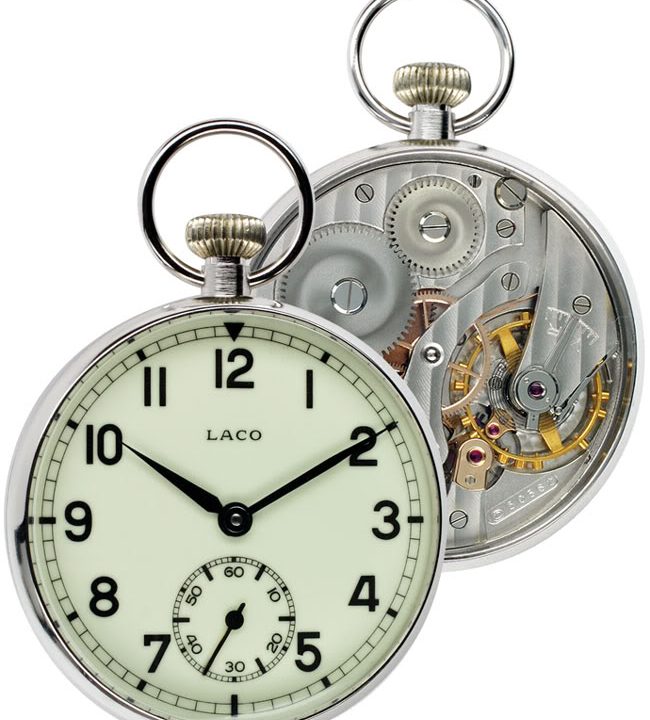
So it was that in 1933 he founded a mechanism-producing company (Durowe -Deutsche Uhren-Rohwerke) which, from the outset, was to supply not only his own LACO plant but other watchmakers as well. The production range was soon to include a wide assortment of high quality wristwatch mechanisms. On offer were two round mechanisms – 8 ¾ (cal. 318) and 10 ½ (cal. 410) lines respectively, and three non-round mechanisms – 5 ¼ (cal. 50), 7 ¾ x 11 (cal. 275) and 10 ½ lines – distinguished by an additional “F” for Formwerk. All of the models were pallet anchor mechanisms with clutch winds, by no means the general rule at that time. Cylinder anchor and pin pallet fork mechanisms were still favored, with full pallet fork mechanisms tending to feature ratchet winds, whose quality and design were considered less sophisticated.
Post War Era
The war ended catastrophically for almost all the Pforzheim manufacturers, including LACO. During an air-raid by the Allies, all the factories were destroyed and more than 80% of the town itself was reduced to rubble. However, the work of rebuilding was to begin soon after the end of the war, and Laco and its sister firm were back in business again by 1949. Helped by the Marshall Plan, Ludwig Hummel built an impressively large 5-storey edifice to house Laco-Durowe, which was later further extended, so that by the middle of the 1950s 1,400 people were working there. Production of rough movements rose to 80,000 a month, giving some idea of the company’s dramatic growth over this period.
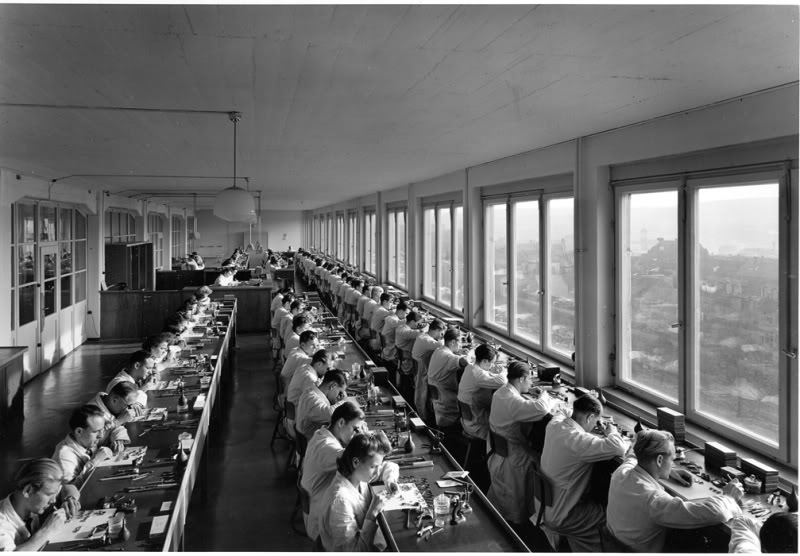
The years up until 1959 may be regarded as Lacher’s “golden age”. LACO enjoyed a strong market position with the manual wind and – starting in 1952 – with the automatic models, while Durowe supplied various watchmakers with an ever-increasing number of reliable and high-quality movements.
Modern History
Fortunately, during the 1980s someone at Erich Lacher Uhrenfabrik, which all these years had continued to exist and produce as Laco’s “little sister”, still remembered the two companies’ joint beginnings, and the prestige of the Laco name. Consequently, on September 8th, 1988 the managing partner Horst Günther acquired the rights to the LACO name and logo, which enabled the company to start producing a modern range of high-quality LACO watches. Even today, most of these watches are mechanical – but they now tick with Swiss or Japanese “hearts”. The fortunes of the firm were in the hands of Andreas Günther, the sixth management generation.
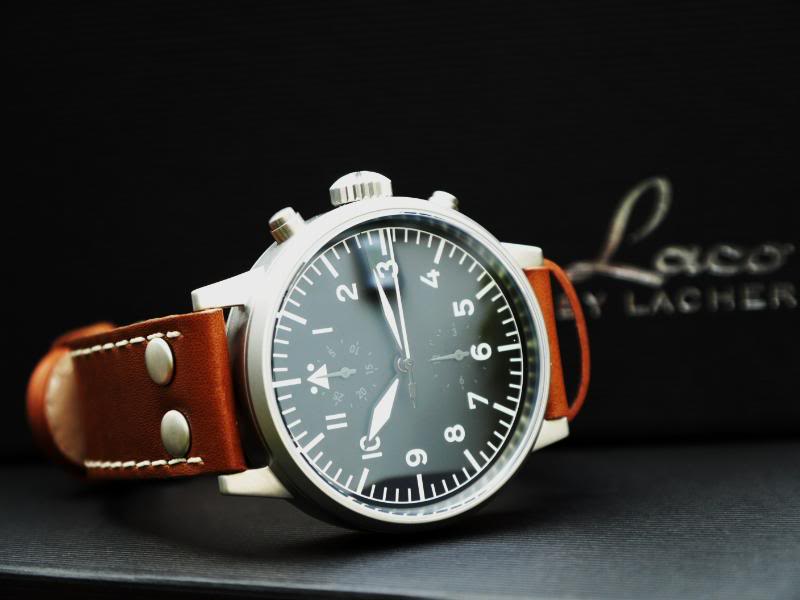
To celebrate the watchmaking company’s 75th anniversary, Lacher re-issued 75 of its legendary ’40s pilots’ watches – 80% of the parts used having been replicated from the original model. All the other components, in particular, the pinions and the wheel plate for the indirectly driven central second hand, were manufactured in limited quantities. The 75 limited edition watches sold for 7.500 DM per edition.
As the anniversary edition of the LACO pilot’s watch was such a great success the company decided to launch a new pilot’s watch series of even higher quality at the beginning of the year 2003. These five new models are available exclusively with refined mechanical movements (Côte de Genève and blued screws) which can be seen through the exhibition back. All those models are equipped with stainless steel cases and a domed sapphire crystal. A luxury presentation box including a spare leather strap underlines the high quality of this new series of pilot watches. Furthermore, it comprises two models with a case diameter of 36 mm which makes them also available for ladies.
Present Day
LACO sailed through troubled waters for some time, but finally had to file for insolvency on 30.06.2009. They tried hard to recover and recapitalize the company and to try to save the work places in Pforzheim. Intensive negotiations with various companies took place. Amongst those interested the KIENZLE AG mistakenly turned out to be the right partner. For a very short period LACO was to be found under the umbrella of the “Kienzle Lacher Uhrenmanufaktur GmbH” but KIENZLE went into liquidation very soon as well.
In spring of 2010 LACO re-started with eight staff members and turned back to their roots: Focusing on manufacture instead of industry. This new direction finally was a successful way into a more prosperous future.
LACO is back on the track and doing well with Uwe Rücker as the new CEO. Since 2010, the company has successfully managed to launch about two dozen new watch models onto the market.
Leipzig Erbstück
Homage is one of the most and widely misused term in the watch world. In an almost accurate meaning of the word and relating to watches a “homage” should be something that shows respect or attests to the worth or influence of a predecessor.

That being said it is evident that every “Erbstück” produced by LACO is a very well made and thoughtful “homage” to the Lacher & Co. flieger watches made during World War II.
So it is no surprise at all that the LACO Erbstück collection consists of both iconic dial configurations, Baumuster Type A and B.
Cases are available in 42mm and 45mm. Movements are the respectable work horse ETA 2824-2 and its family member ETA 2801.
Innovative treatment of the surface in various levels of aging is simulated with signs of wear and tear, thus giving the watch the very special appeal of a historic timepiece. But this watch that bears scratches, supposed traces of rust and comes with an antique strap is actually brand new.
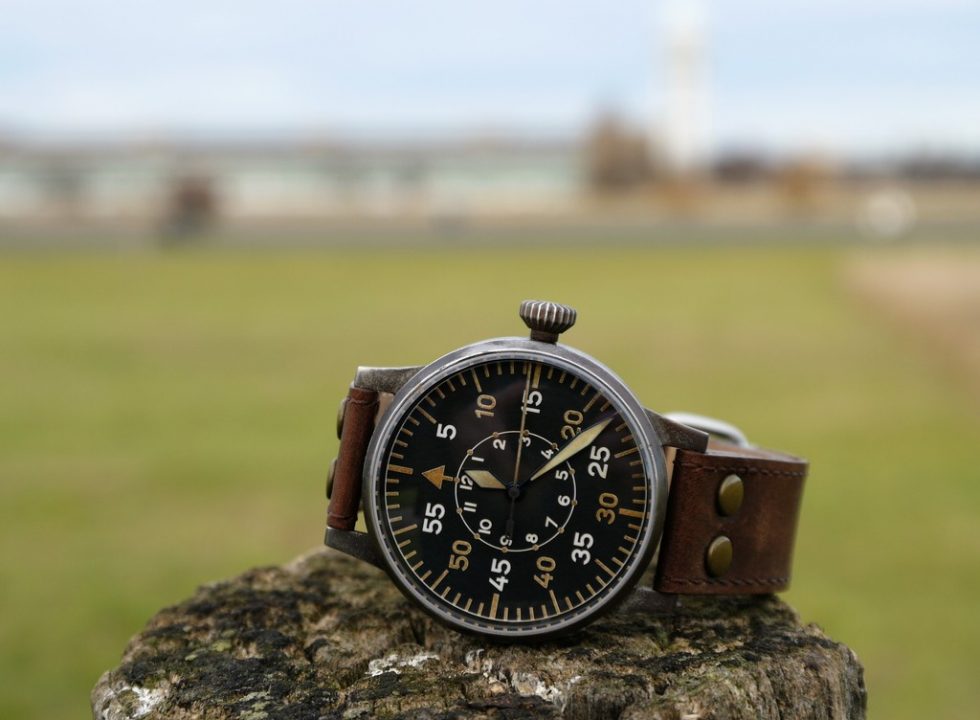
LACO has developed a process that gives watches an artificial patina of age, enhancing them with historic charm.
The name – Erbstück” (translates into heirloom) – was created when Watchuseek met with Laco’s new CEO Uwe Rücker and Dorothea, Ursula and Sarah at LACO’s booth in Basel. In March 2016 LACO presented the prototype of this timepiece at Baselworld, the most important international watch and jewelry fair worldwide. According to LACO, the response from visitors was “overwhelmingly positive.”
Here are some Baselworld 2016 pictures to show how the prototype looked like at that time:
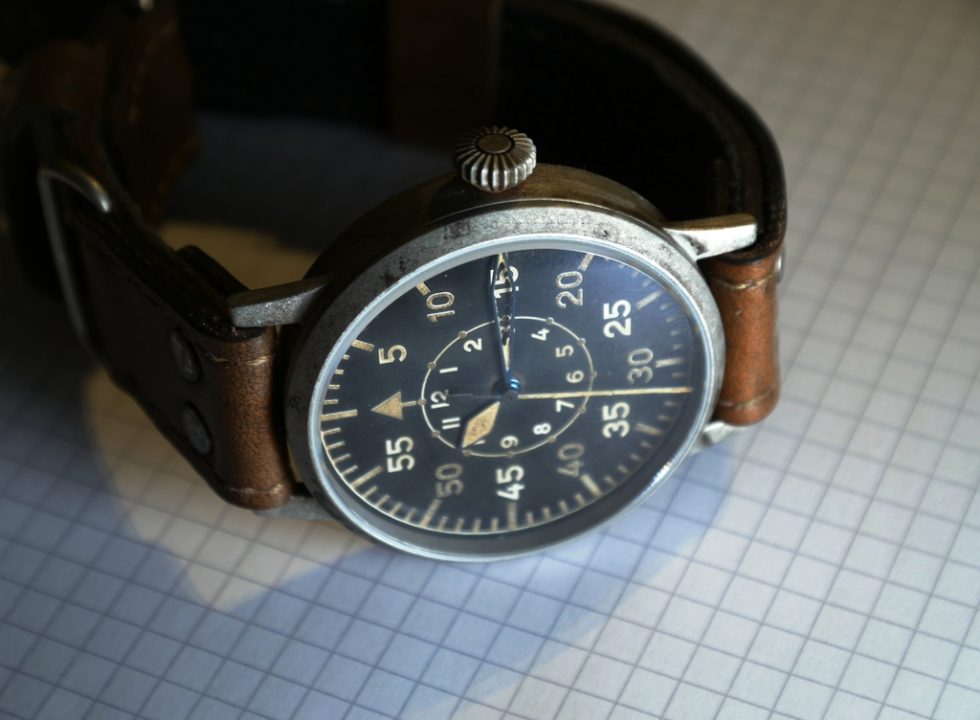
By then the prototype of this watch shown to us had no name. It took us only a couple of minutes of joint brain storming et voilà we thought of a suitable name in almost no time.
The “Erbstück” was born. The name was perfectly obvious. Usually you’d call it an inherited time piece, a drawer or attic find, and most of those pieces would show signs of (heavy) wear and tear. To find a NIB (New-in-Box) WW II-Beobachtungsuhr is almost impossible, so Erbstück creates the impression of having been worn for several generations.
Pilot watches have been LACO’s playground for over 80 years. Just how attached the owners of these traditional timepieces are to their treasures becomes apparent when even heavily scuffed and extremely stressed specimens show up in Pforzheim for repair.

“Repeatedly our customers have let us know that scratches and other marks of the ravages of time are precisely what constitutes the character of their watches, which is why they particularly appreciate them” CEO Uwe Rücker stated. That is how the idea originated to artificially help the decades’ long ageing process along, thus transforming the original into an antique replica with just a few days of work.
To create an “Erbstück”, the case of a stainless steel pilot watch is individually hand-finished by a metals expert to produce the “visual effect of rust”. The dial is given an “aligned” patina to underline the wear and tear effect. The prototype’s hands’ luminous material was uneven and cracked to the extent that it no longer appears to exist on the hands. That changed significantly with the current line-up.
The thermally blued hands are still hand-finished and artificially aged by sticklers for details and generally completely coated with Superluminova (C3). Partially cracked hands are available on special request only. I decided to go with hands being well artificially aged but “complete” for the sake of readability. Even those are hand finished and you can see some spots of color deviations.


From the blueprint to applying the finishing touches everything is crafted by hand and driven by passion to deliver precision, clarity and character. All watches do of course have the LACO characteristics in common, however – and this is pivotal to know – no two watches are the same. Admittedly they might look similar but they are not. Handmade in Germany conveys a meaning for every Erbstück.
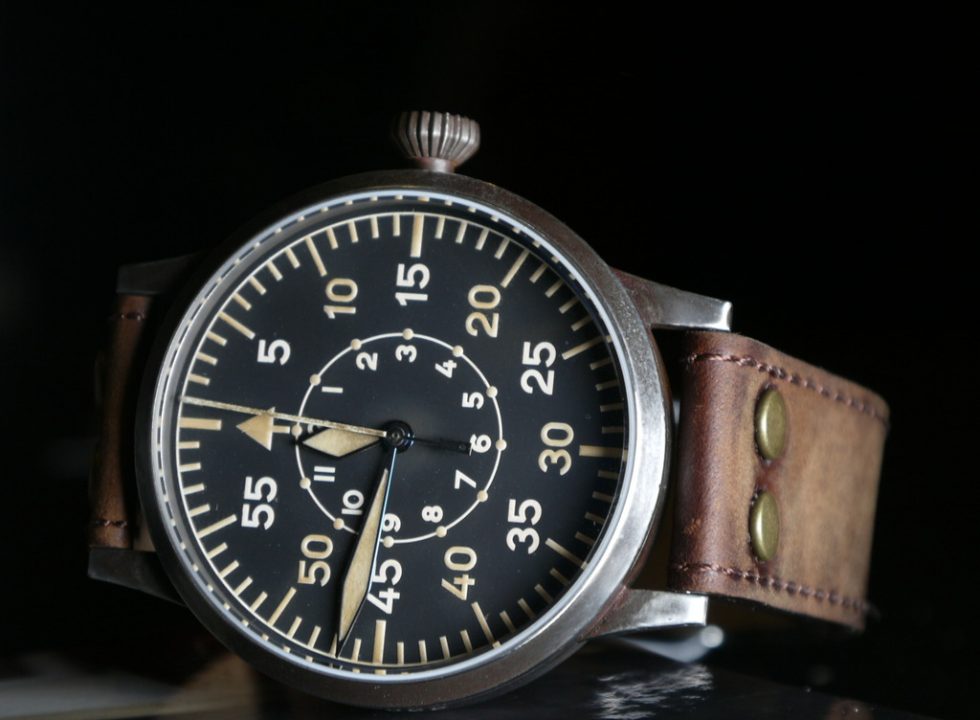
The attention to detail and the manufacturing process with hand-finishing have an impact on the delivery time (presently 3-4 weeks) and – of course – cost which is almost the double (€850 for normal edition vs. €1648 for Erbstück).
When visiting the Munichtime 2016 I spent a couple of hours to handle the Erbstück in the flesh to make up my mind on which Erbstück to order. After having handled the Erbstück in Munich I decided to order the 42mm Leipzig Erbstück with the hand winding Laco 01 movement (ETA 2801 base) in a mildly aged grade (Alterung “mittlere” Stufe). As already mentioned above I decided to go with hands being well artificially aged but “complete” for the sake of readability.
Case, Crown & Pushers
The perfectly sand-blasted stainless steel in antique look is only one of the eye-catching highlights of the LACO Leipzig Erbstück.
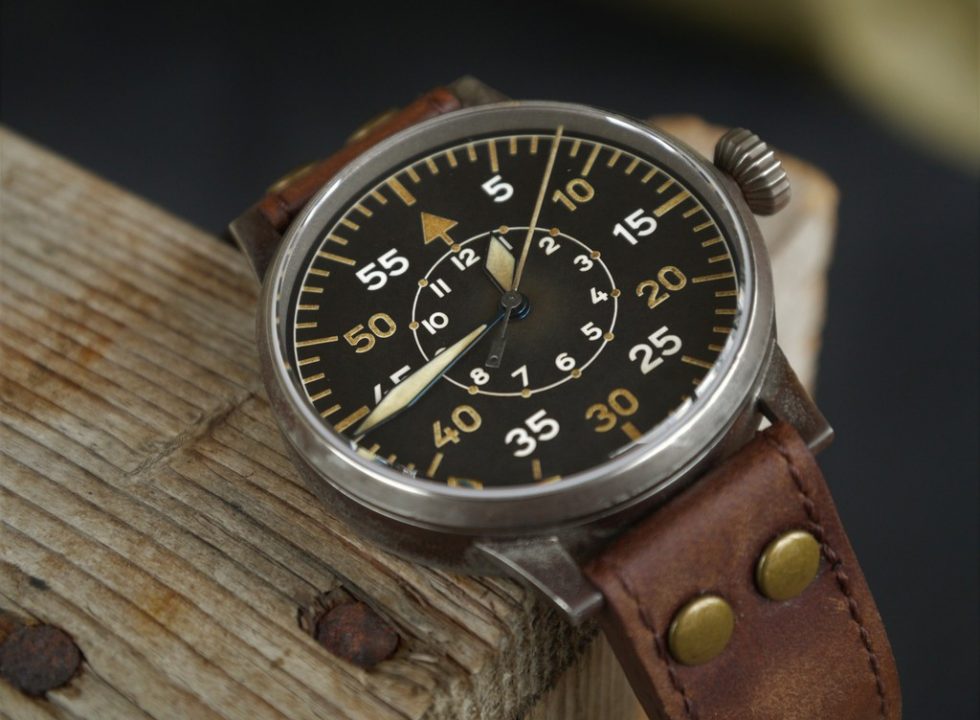
The case and diamond crown convey a unique antique look. Finished by hand case and crown look somehow distressed, rubbed off, weathered, dinged and (slightly) scratched but nevertheless very solid. I really like the look of this aged metal. No fear to leave any fingerprints on this specially treated stainless steel case.
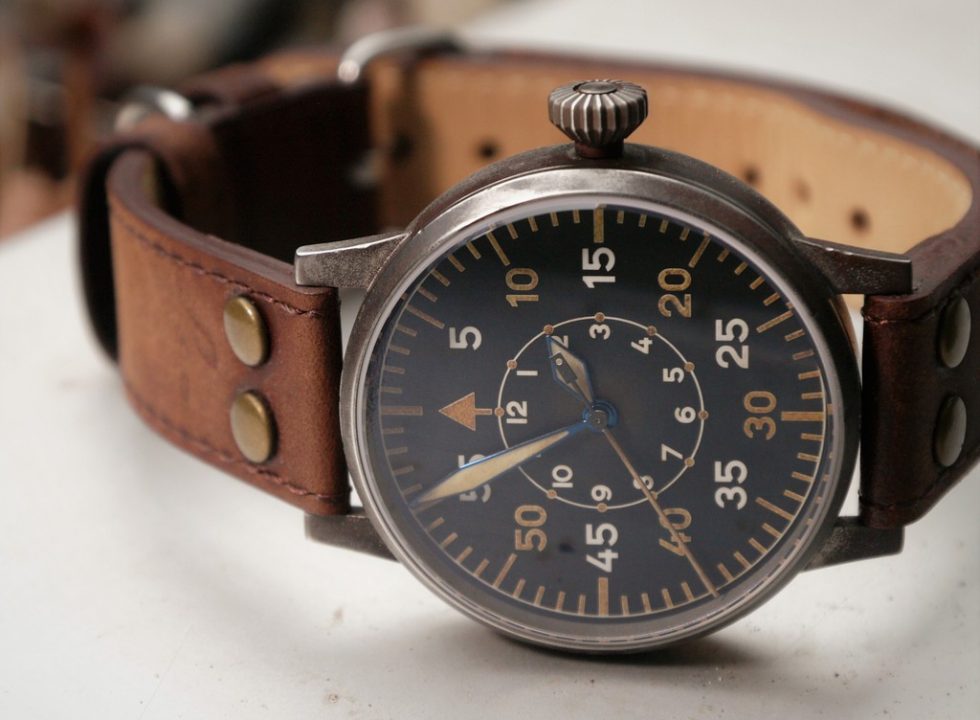
The 42-mm diameter looks great even on a smaller wrist (6.5 inch) and with an overall height of 13 mm the Leipzig easily fits under any shirt cuff.
The Leipzig Erbstück has the FL 23883 engraving on the left side of the case.
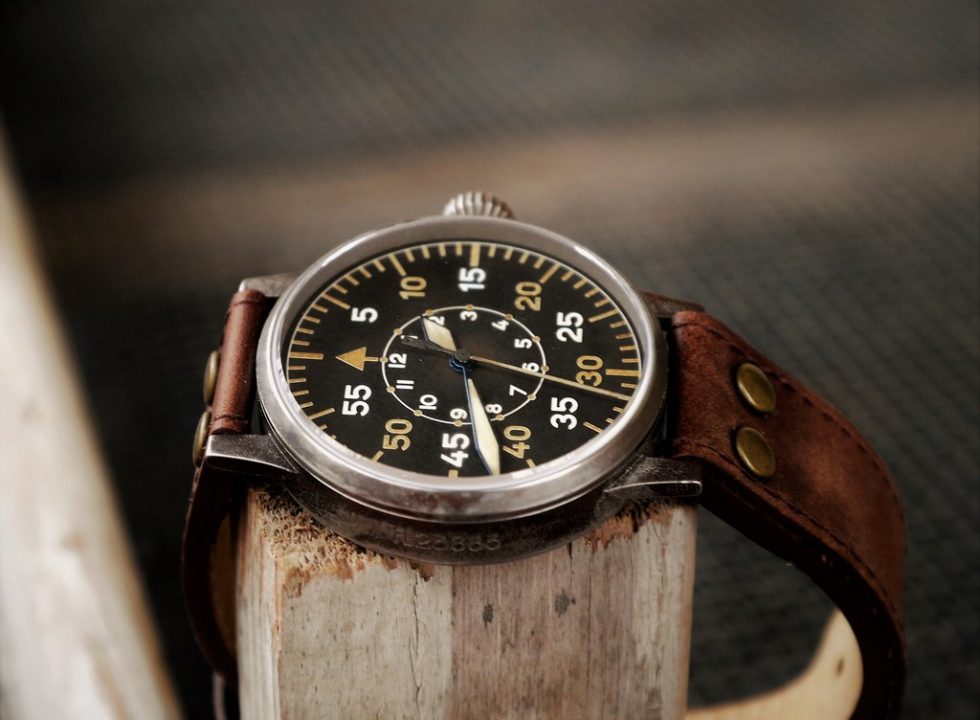
The crown is the typical diamond crown in the style we are accustomed to with its predecessors of World War II.
However, the crown shows artificial wear and tear as well. Looking more closely at it you’d think it has aged well over a several years.
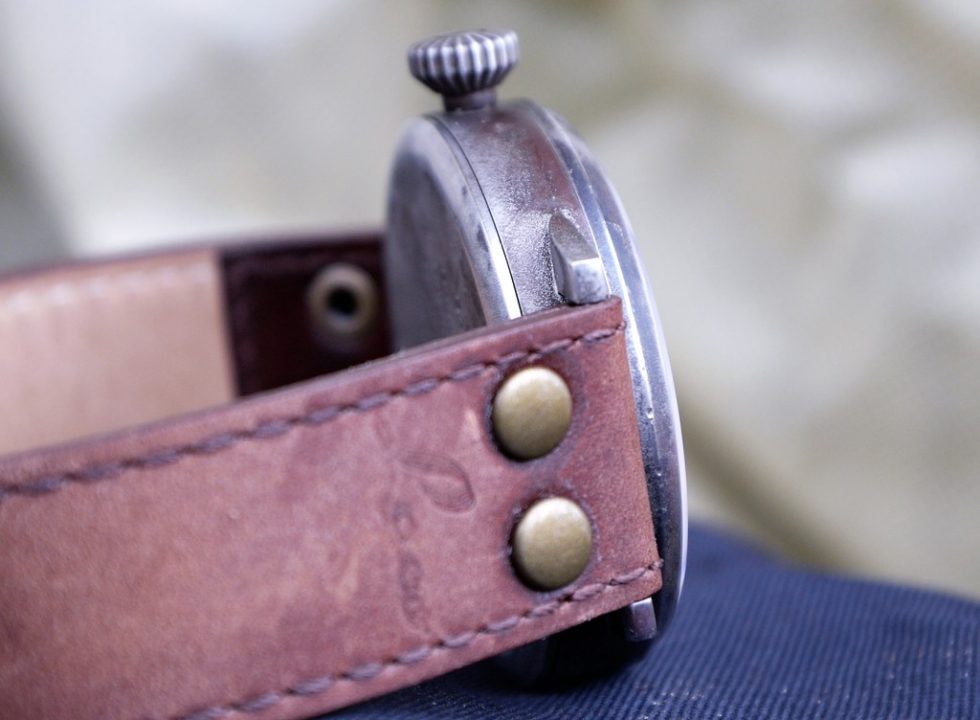
Out of the box you will not feel any friction when winding the watch. Winding the watch is very smooth. The crown itself feels solid enough to overcome thousands and thousands of pull out / push in and winding operations.
Following the patterns of its predecessor the solid case back is a press-on one with a noticeable gap to open the case back with a watchmaker’s knife and engraved in the style the predecessors’ case backs were engraved as well (inside):
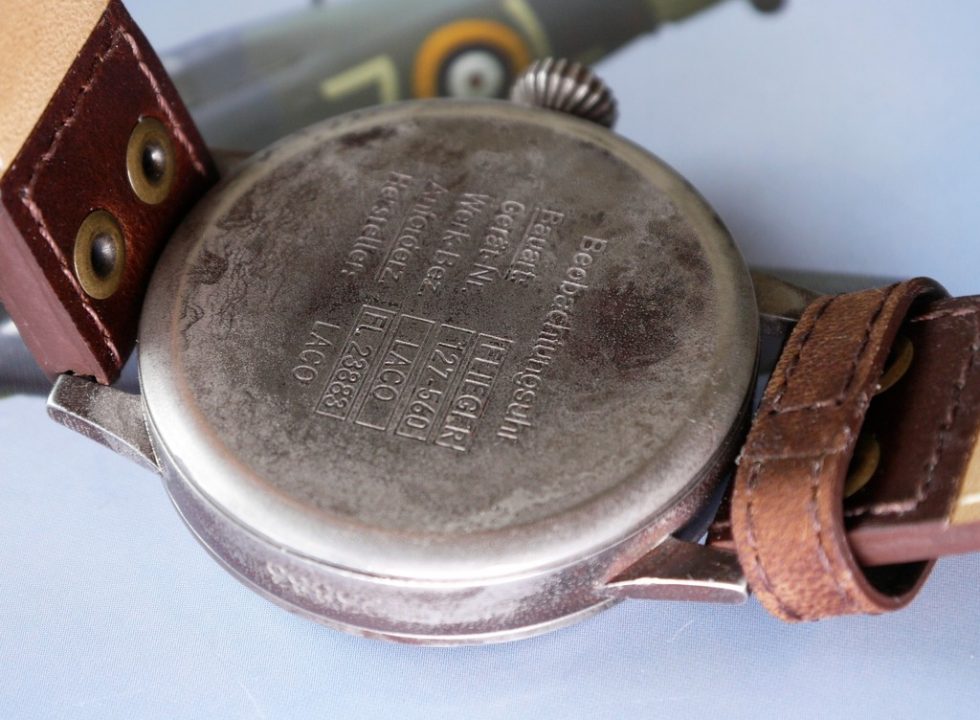
The “new” case back is also elaborately finished by hand and does look like being rubbed-off, glossy at the edge, stained in the middle.
Movement
The watch is powered by an ETA 2801, elaboré grade. This 17-jewels-movement is known to provide a power reserve of +/- 42 hours and is commonly known as a very reliable workhorse as is its family member 2824-2.
It would be too early to give a full report on the accuracy of my Leipzig Erbstück because I haven’t worn it long enough. I am already satisfied as it performs out of the box with +3/+4 seconds/24 hrs.
Dial and hands
The LACO Leipzig Erbstück dial is manufactured following the Baumuster B requirements of the Reichsluftfahrtministerium (RLM).
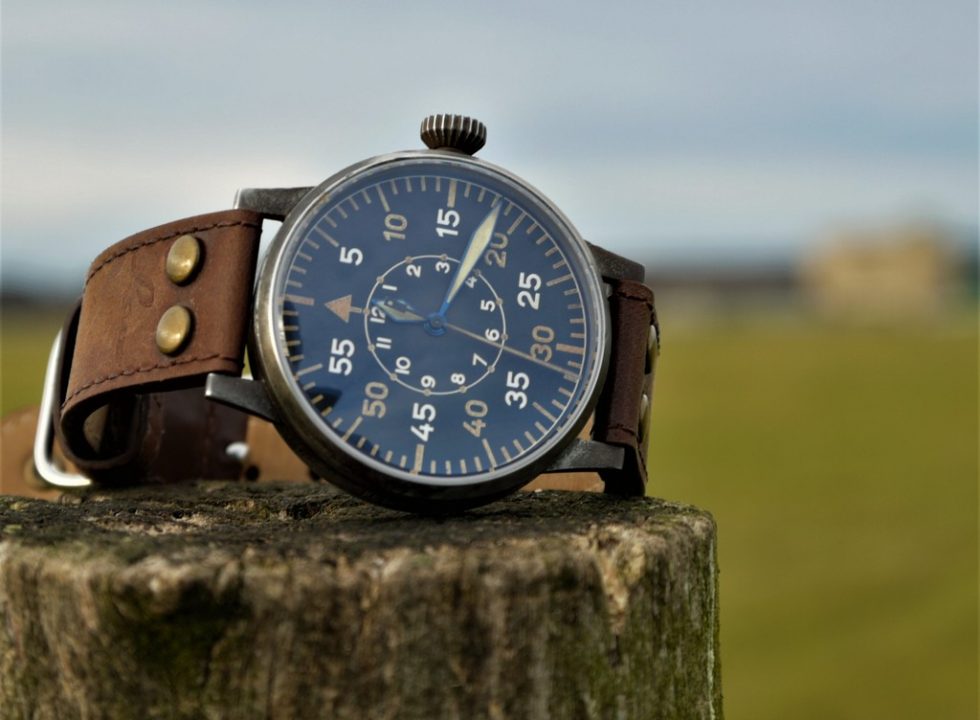
Except for the use of Superluminova C 3 (the original watches used radium), it is very close to the looks of the 55mm WW II Laco B-Uhr carried out in black matte.
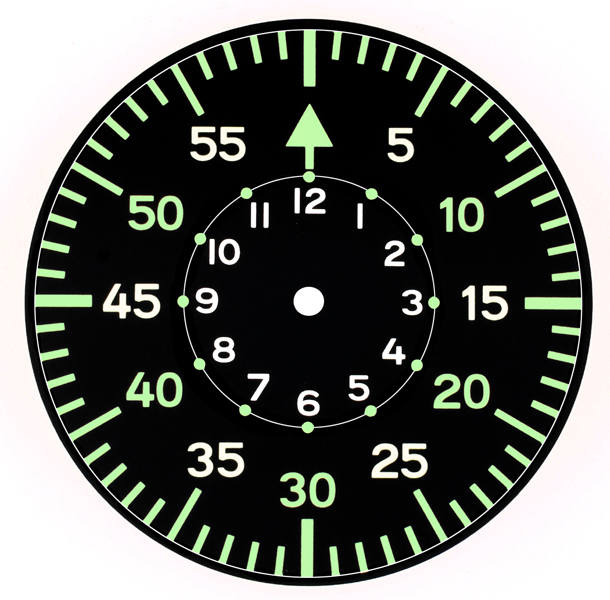
Lume: The even minute numbers (10, 20, 30, etc.) and indexes on the outer circle are coated with luminous material, as well as the dots of the inner hour circle.
The odd numbers (15,25,35 etc.) and hour numerals are not coated and thus they stay white.
The dial is aged as well to underline the vintage look and feel.
The luminous hands are thermally blued but that’s par for the course. The compound used is Superluminova C 3. For the sake of better readability, I decided to go for non-cracked hands.

However, it should be noted that the hands are “decorated” by hand in a similar way case and dial are finished. So, a closer inspection in the daylight will reveal that the Erbstück hands are partly artificially aged as well. They do feature darker spots/stains and these spots/stains as tiny as they are do have some (minor) impact at night.
There is less readability but the rest of the non-aged Luminova compound is sufficient to warrant readability at night. I dare to say that night owls will not enjoy the watch as much as I do. The Erbstück definitely does not glow like a torch in the night. Then again, without these stains and spots the overall impression would not be the same.
The aforementioned fact implies that no set of hands is 100% identical to another set.
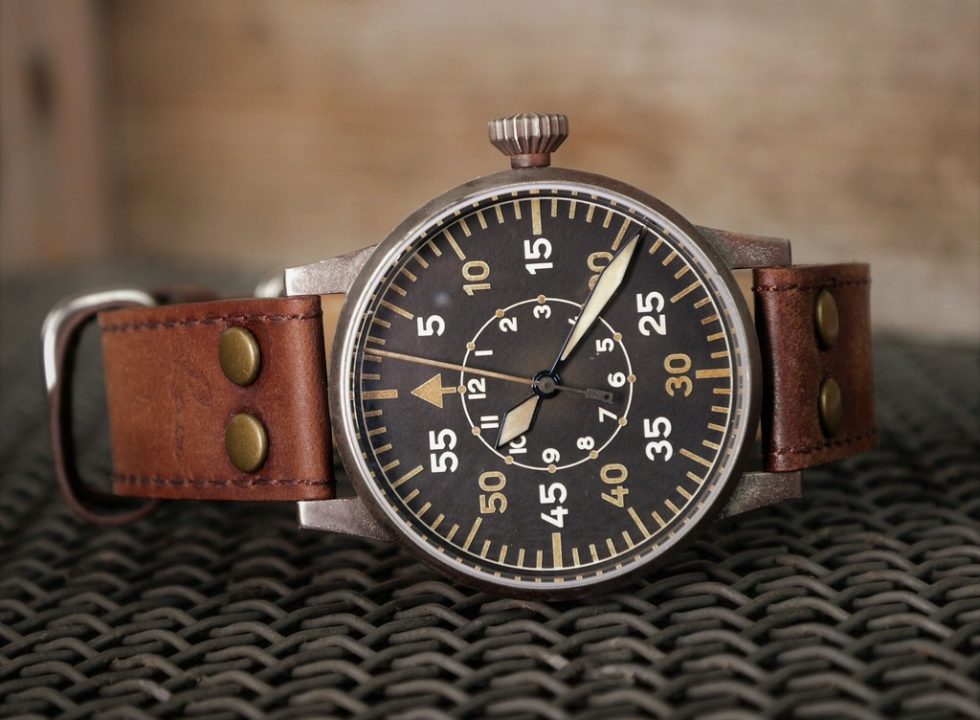
All three do fit perfectly in length and width. The tip of the minute hand exactly meets the outer circle as it is supposed to do. Same is valid for the seconds hand. The shorter but bigger hour hand ends at the border of the inner circle.
Crystal
The watch is fitted with a domed sapphire crystal which does not line up precisely with its bezel. It’s raised a bit which – again – is in accordance with the looks of its historical predecessor and contributes to the vintage vibe.
The crystal is AR-coated on the inside only. Not sure if you can request for AR coating on both inside/outside as an option.
Strap
The LACO Leipzig Erbstück is fitted with a closed loop brown pilot calf leather strap with rivets, 20mm lug width. Close to the rivets the buckle side of the strap is embossed with “LACO”.

This strap is a genuine antique one since it is made from historic postal and military bags which makes each “Erbstück” strap one of a kind.
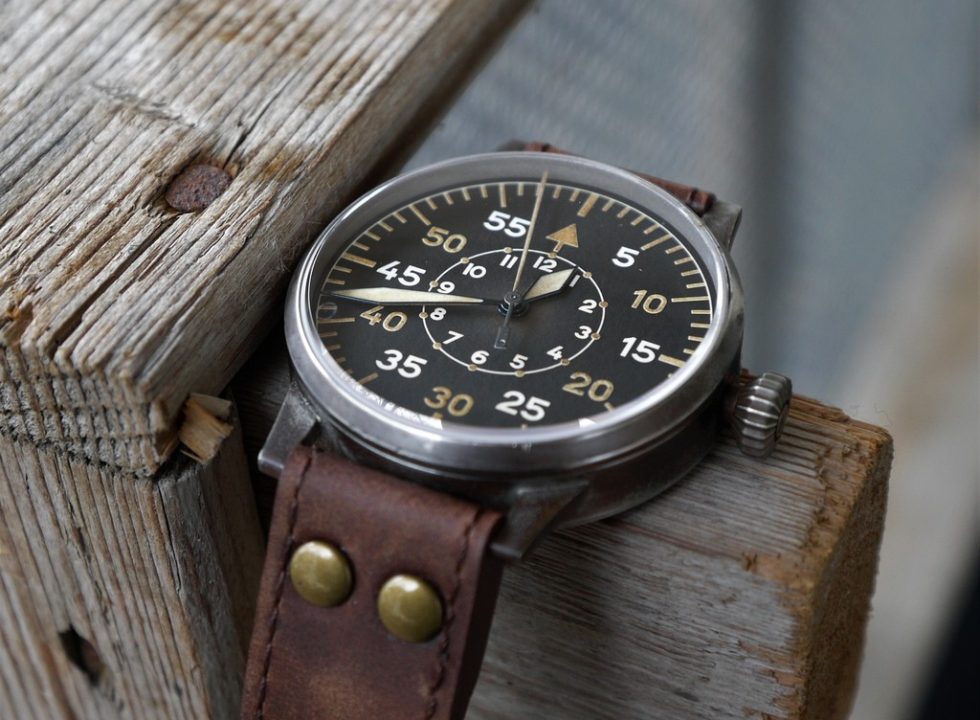
The strap surface feels soft, suede like. Despite how the top feels, the strap appears as worn-in vintage. The shiny stainless steel parts are not treated in the way the case is to give a complete vintage look. This is something LACO should reconsider.
Box and Manual
The LACO web site mentions a “Black gift box, incl. cardboard box”, but my watch came in a lovely wooden box (walnut veneer) wrapped in a white cardboard box.
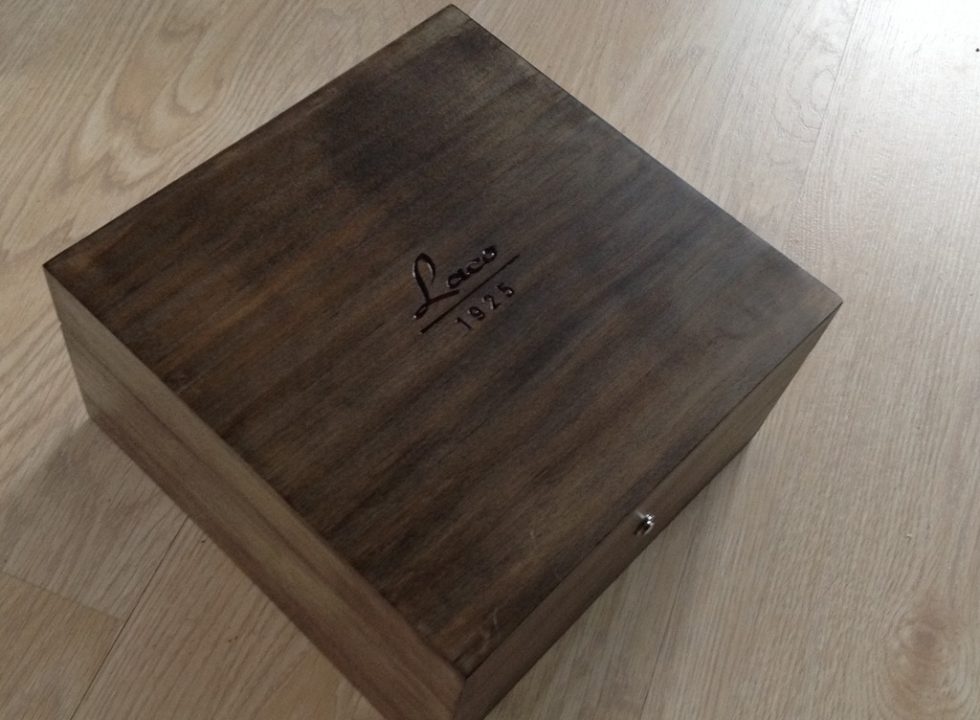
The wooden box itself is fitted with a yellow-brown (sand) colored inlay with two compartments, one for the watch, the other one for the manual.
The watch itself was provided with two tags, iF Design Award 2015, and a bar code sticker on a small piece of leather “Laco 1925 Made in Germany”.
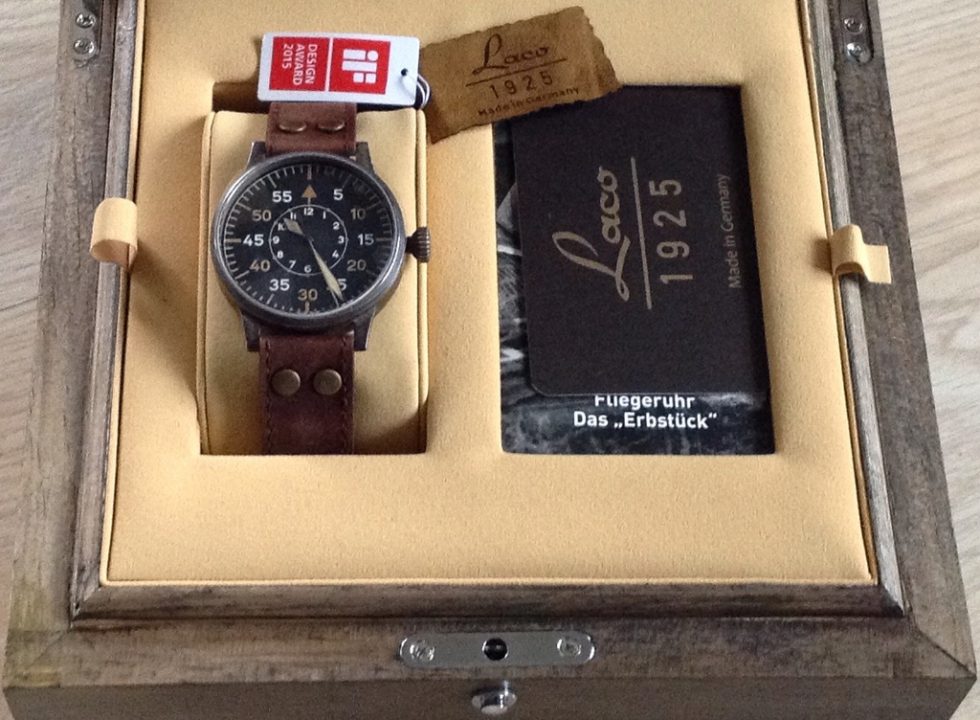
In the second compartment, you will find the guarantee card, a small manual explaining how to operate the movements and giving some info on water resistance and hints on service and costs and a leaflet with very brief information on the Erbstück.
Price
Price is 1648 Euro but outside of EU the price will be less due to VAT savings.
Warranty
The watch comes with a 2 years warranty.
Summary
LACO surpassed my expectation by launching the Erbstück models.
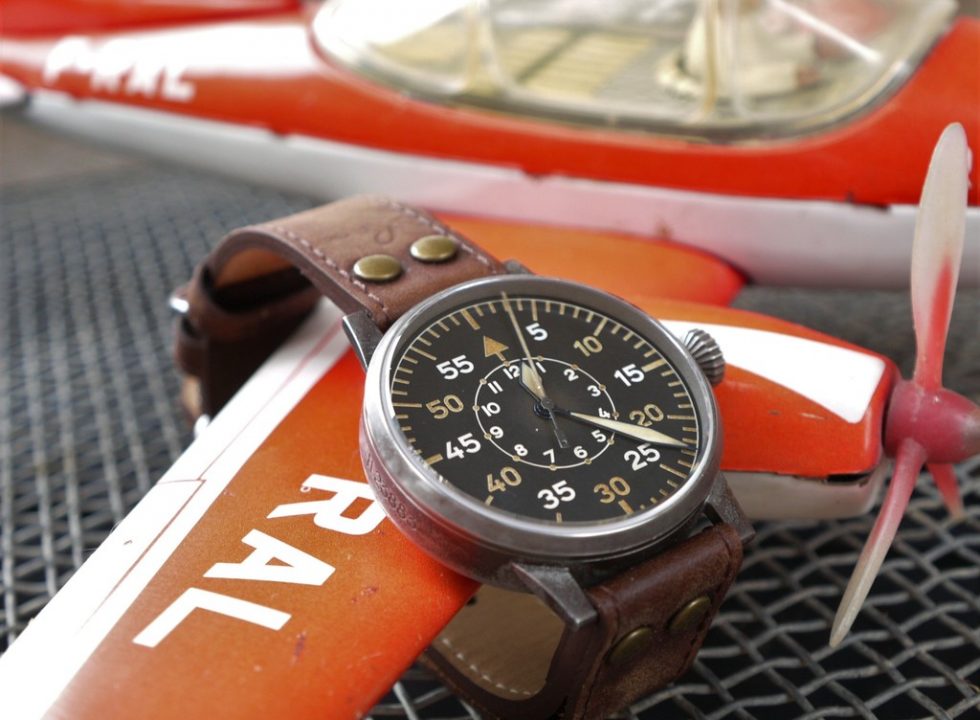
The Erbstück is far away from being just a gimmick, it is inherently consistent, well thought out, and sophisticated. The aging process is state of the art and the watch has an unassuming vintage vibe.
Story by Mike Stuffler and Bhanu Chopra
Photo Credit: Mike Stuffler

